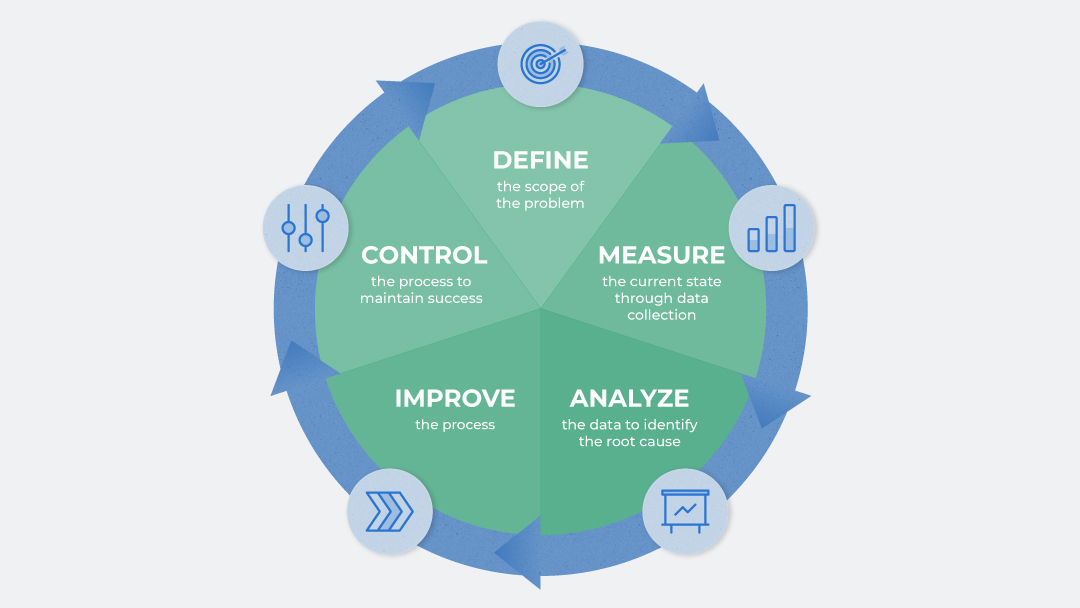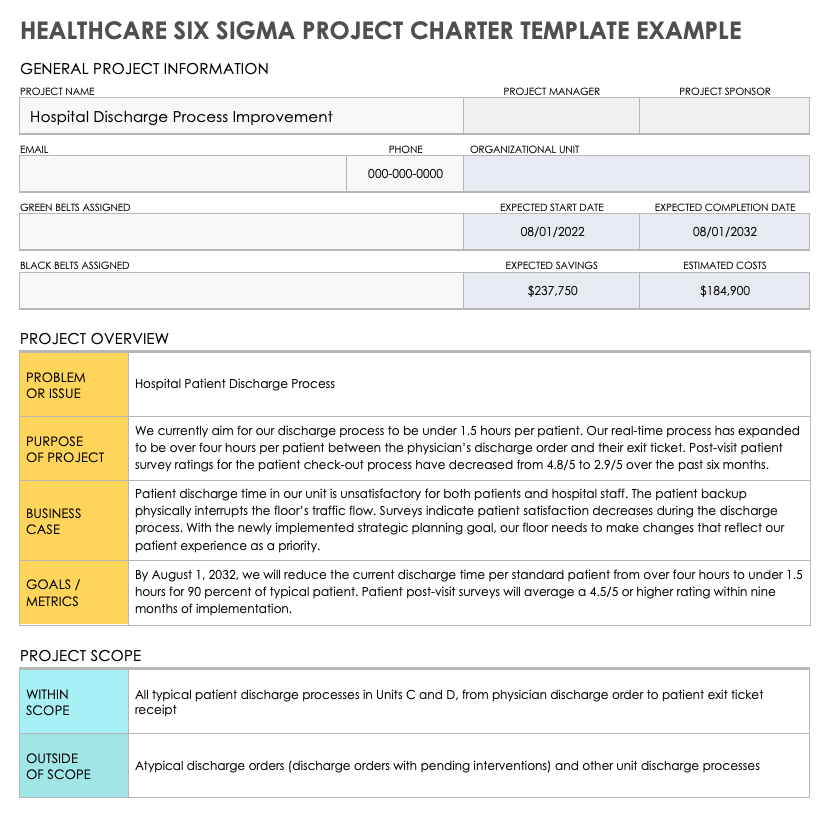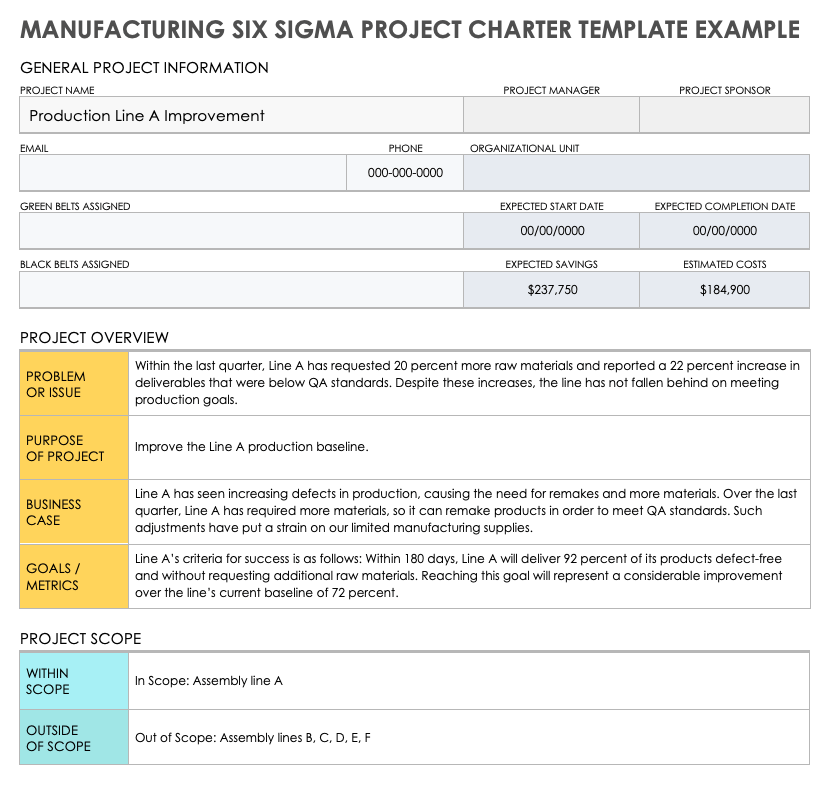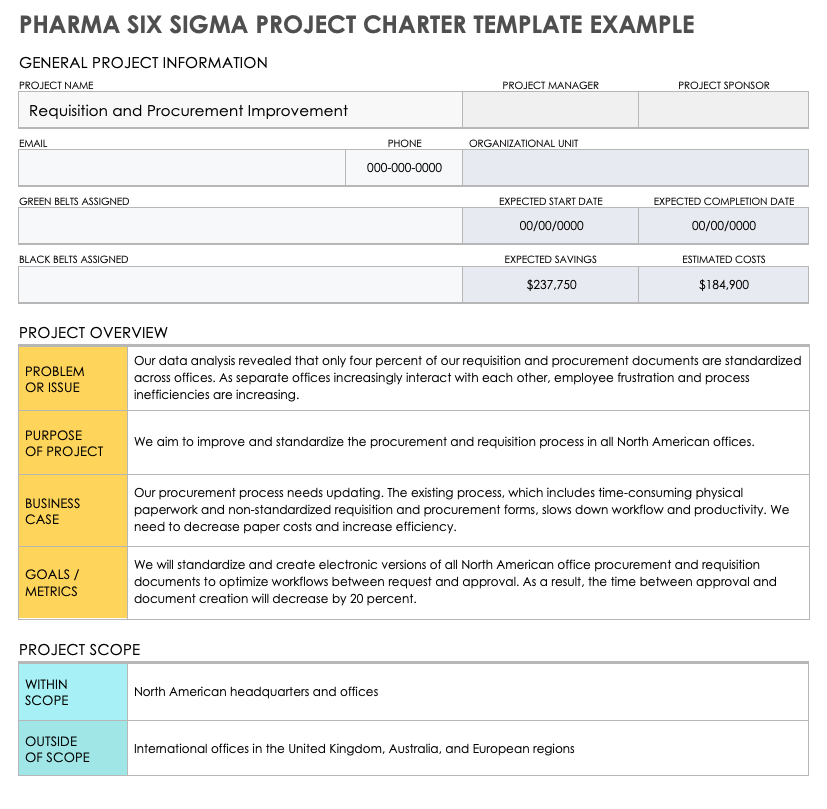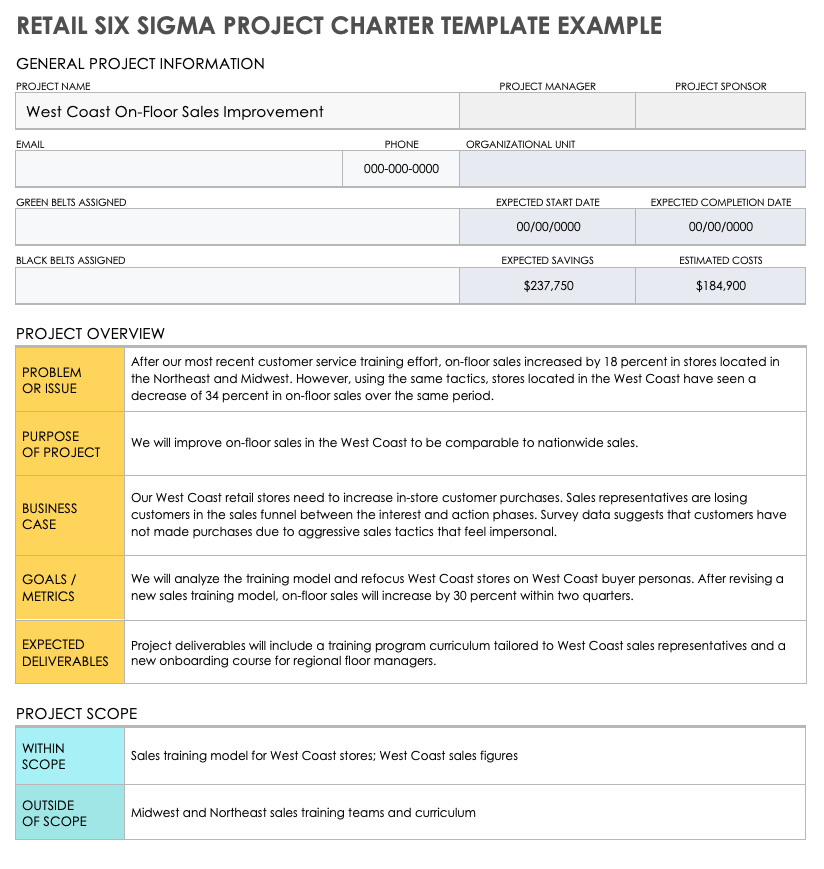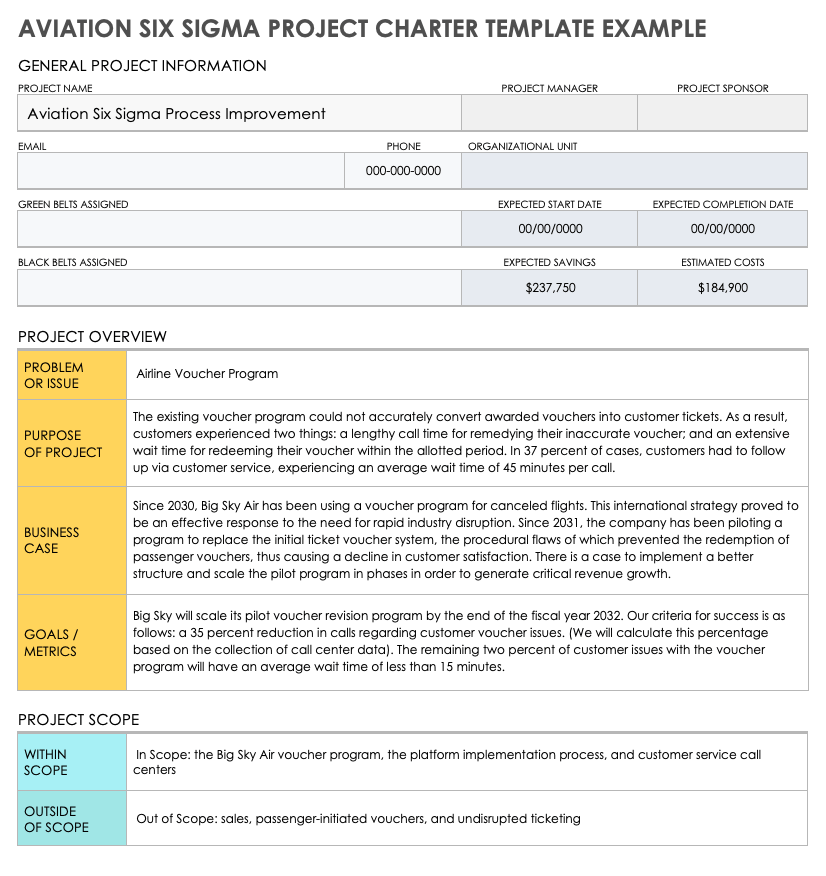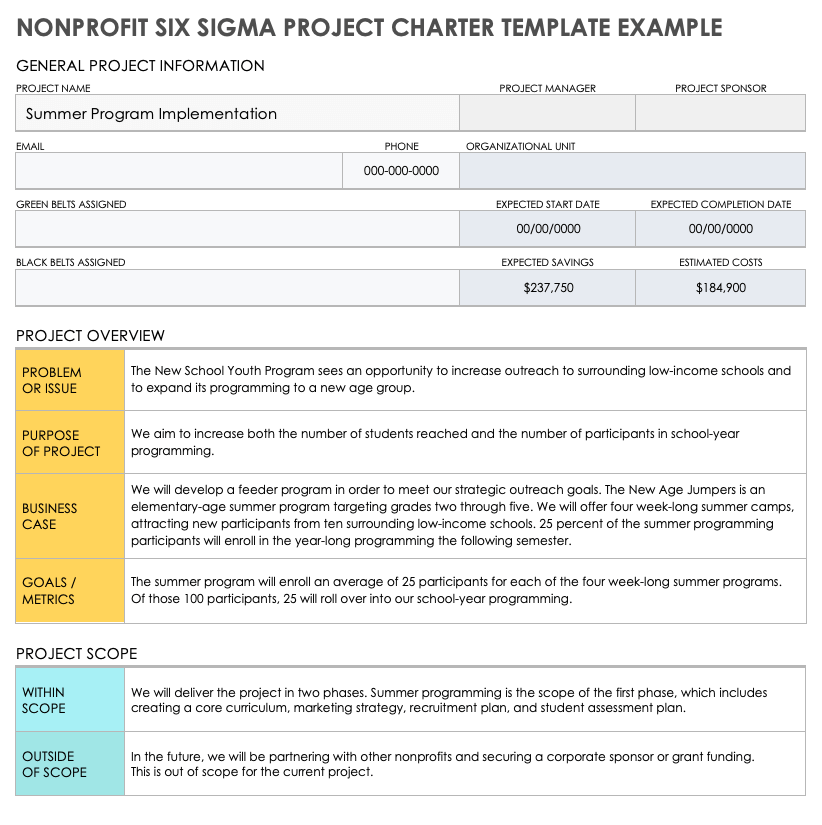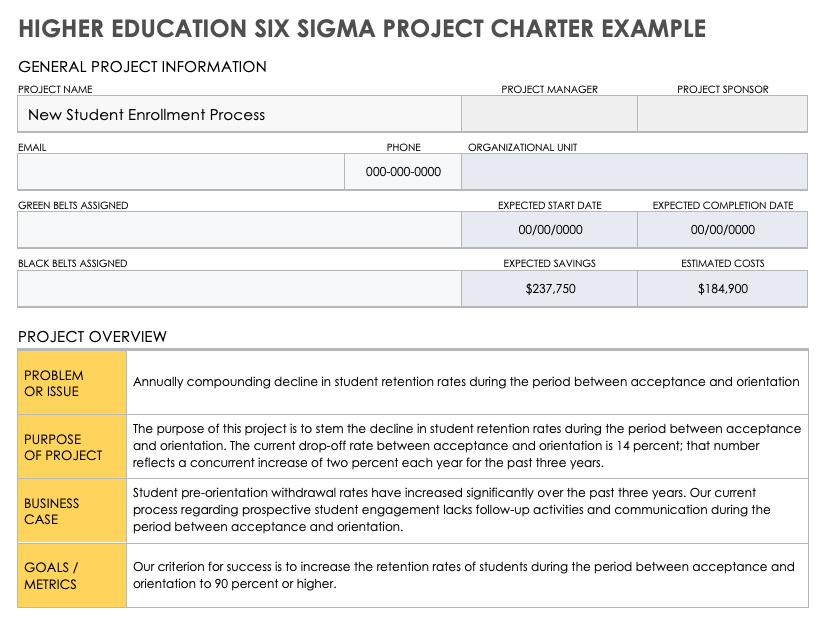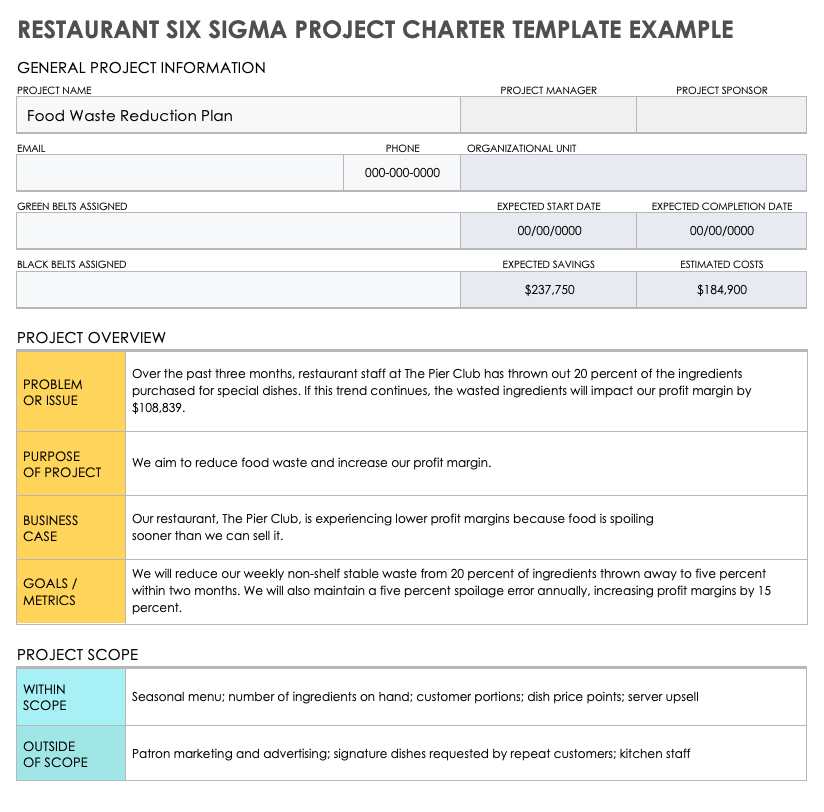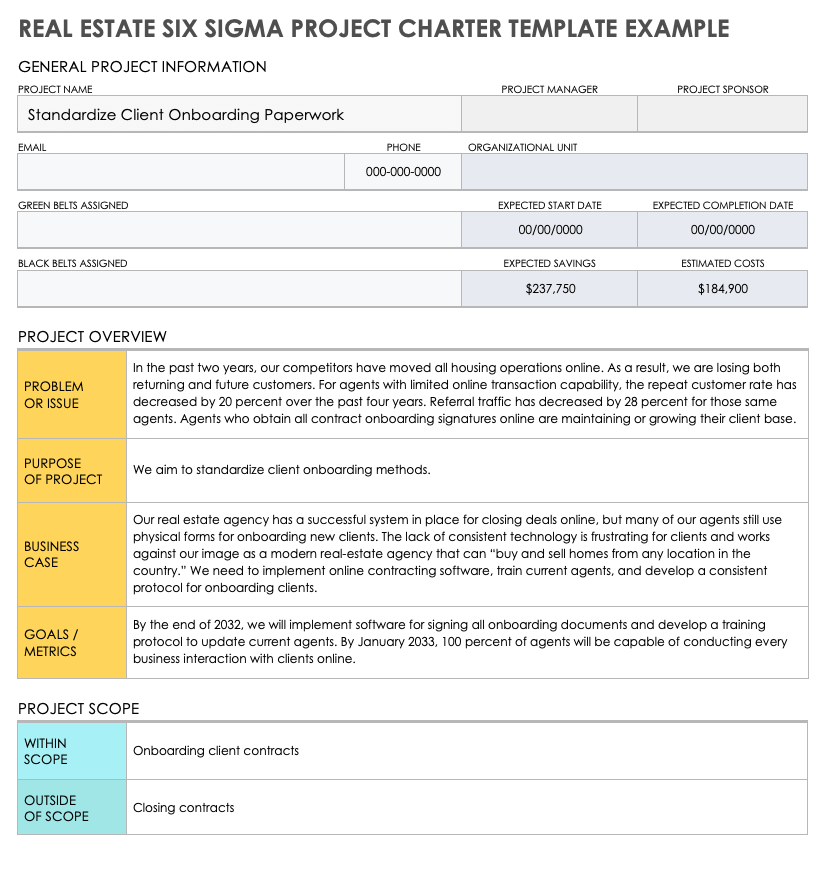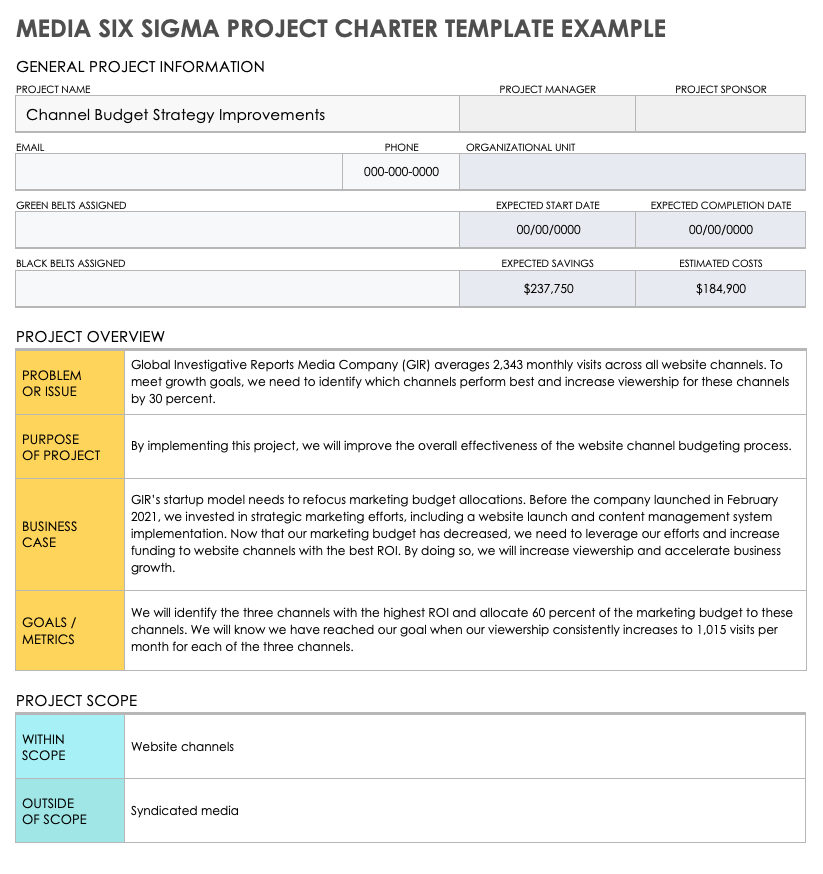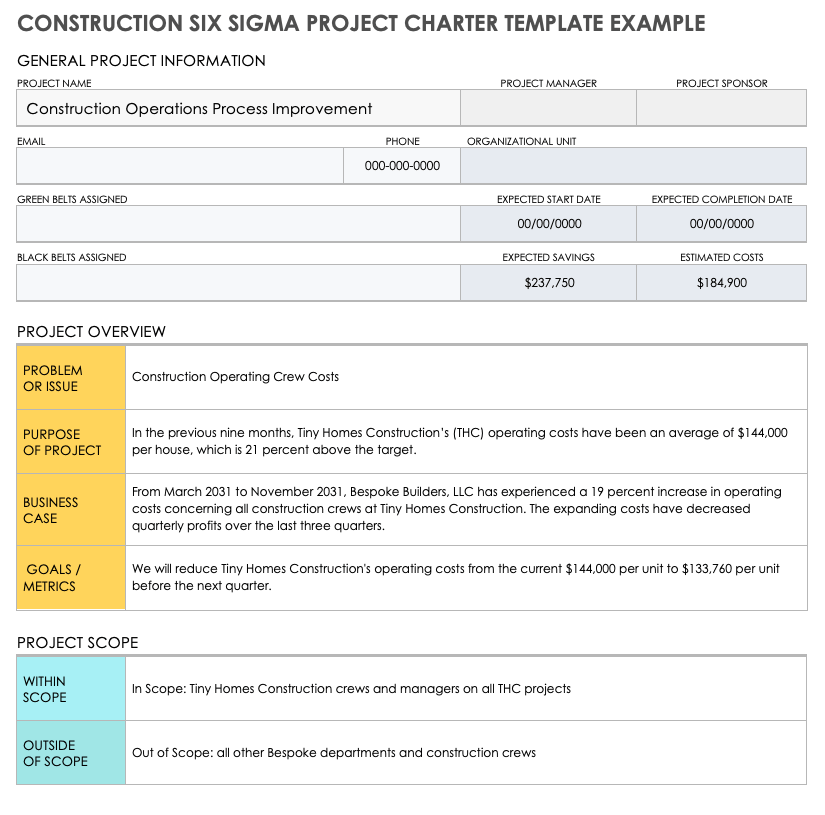What Is a Project Charter in Six Sigma?
A project charter in Six Sigma is a two-page document that outlines a process improvement project. The charter contains data-driven information explaining the need for the project. Once approved, the document becomes the Six Sigma team's primary reference.
Like traditional project charters, a Six Sigma charter is the initial document that communicates a project’s purpose. It is also a living document that the team will update and review throughout the lifecycle of the project.
Both traditional project charters and Six Sigma project charters share these key elements:
- Agreement: Document an agreement between the project team and management.
- Alignment: Align project goals with the goals of the entire organization.
- Business Case: Present the business case for the project.
- Outline: Provide a broad outline of the project.
- Overview: Describe the project’s objectives, necessary resources, and timeline.
- Project Scope: Define the project scope.
- Reference Point: Act as a reference point throughout the project.
Unlike a traditional project charter, a Six Sigma charter requires a team certified in Six Sigma methodology to prepare and execute it.
In addition to achieving the goals outlined above, the Six Sigma project charter will contain:
- Six Sigma Certifications and Roles: Designate the team members assigned to the project, and include their Six Sigma certification and project role.
- Six Sigma Methodology: Identify the Six Sigma tools and methods you plan to use to refine the business processes.
- Six Sigma Statements: Identify the process improvements the project will accomplish, and outline any potential implementation issues.
What Is a Lean Six Sigma Project Charter?
A Lean Six Sigma project charter looks the same as a Six Sigma charter. Some experts believe that there is no significant difference between the two. Others explain that Lean charters focus on preventing issues rather than making incremental improvements.
The difference between the two is subtle. Similar to a Six Sigma charter, Lean Six Sigma methods and tools help teams eliminate waste in a process. The Lean charter reflects this approach in the goals.
“Both charters are the same in the structure, but they are different in the goals,” explains Mahmoud Al-Odeh, Professor of Operations and Technology Management at Bemidji State University. “The Lean Six Sigma charter includes goals related to eliminating waste and non-value-adding activities. The Six Sigma project charter includes reducing variation in the process to reach a Six Sigma level, or 3.4 defects per 1 million opportunities.”
To prepare a Lean Six Sigma project charter, start with a standard Six Sigma project charter template. Craft a Lean goal statement that targets issue prevention or preemptive waste avoidance. A Lean goal statement might say, “We will identify and remove all non-essential steps between intake and examination, such as repetitive forms and paperwork, to reduce patient wait time by 10 minutes.”
However, George Eckes, the author of five books on Six Sigma who has over 30 years of consulting experience in Lean Six Sigma, process management, and process improvement, does not believe there is a significant difference between the two charter types.
“To some purists, Six Sigma is aimed at reducing variation exclusively, while Lean is aimed at improvement,” he explains. “I am not a purist. Of the thousands of project teams I have coached, 100 percent of their charters reflected an improvement of effectiveness (i.e., reduction of variation around some target), while at the same time improving efficiency (e.g., reducing cycle time). Thus, there is no difference to me between a Lean Six Sigma Charter and a Six Sigma charter.”
Who Prepares a Six Sigma Project Charter?
A project champion prepares the Six Sigma project charter. This team member owns the process and coordinates a team of certified Six Sigma Green and Black Belts. They also rely on subject matter experts (SMEs) to provide relevant project information.
With the exception of the SMEs, all team members working on the charter must have a Six Sigma certification.
These are the different team roles, according to Eckes:
- Project Champion: The project champion is the process owner and a liaison between management and the project team. The assigned champion’s primary responsibility is creating the charter. Eckes suggests calling the charter the preliminary charter in order to reinforce the concept that “the charter is a living document and will be modified by the champion over time with newly collected data.”
- Black Belt or Green Belt: The project champion designates one Black Belt or Green Belt as the team leader. A Black Belt leads projects full-time, whereas a Green Belt leads projects part-time. Eckes explains that “more resources are needed for companies to have Black Belts. Most teams do not have these resources, so they use Green Belts. The Green Belts hold down regular jobs and become a Green Belt for the duration of the project.”
- Team Members: Many of the team members who contribute to the Six Sigma charter do not train in Six Sigma methodology. These team members are SMEs and conduct most of the project work. They work closely with the team leader and project champion.
- Master Black Belt: A Master Black Belt advises the organization on Six Sigma practices. “Most organizations have a handful of Master Black Belts who can act as ad hoc team members assisting each team member, Black Belt, or Green Belt with the more difficult Six Sigma tools,” says Eckes.
Each organization will have a unique team structure depending on their resources. For example, some businesses might have several Green Belts and no Black Belts. In this case, the Green Belts will work with the project champion and Master Black Belt.
How to Prepare a Six Sigma Project Charter
A Six Sigma project charter takes up to six weeks to prepare, depending on the project size. The project champion organizes the team and assembles the data into a short document. Champions liaise with management and stakeholders for each activity.
The steps to writing a Six Sigma project charter are similar to the process for other project charters. A key difference is that Six Sigma project charters will designate roles and responsibilities based on Six Sigma methodology.
As they would for any project, the champion organizes and assembles the charter during the first project phase. This is true whether they are using either of the Six Sigma methodologies: DMAIC (define, measure, analyze, improve, control) or DMADV (define, measure, analyze, design, verify).
DMAIC is the most popular method for Six Sigma projects. During the define phase, the project champion leads the following activities:
Collect Data
The project champion assigns data collection responsibilities to Green or Black Belts. This team works for a few weeks to gather any data that supports the project. The champion then inputs the gathered information into a charter template and works with the team to fine-tune the document.
Weigh Competing Priorities
The team identifies, weighs, and prioritizes all project tasks. This activity helps to maximize the team’s time and to manage scope creep. Teams use a quadrant chart, called a PICK chart (possible, implement, challenge, and kill) or a payoff matrix, to determine which actions deliver the highest payoff while using the fewest resources.
To use a PICK chart, create a chart with four quadrants, as you see in the image above. Then discuss and place each project activity on the chart.
These are the four quadrants of a PICK chart and what they represent:
- Possible: Low-difficulty, low-payoff items that are possible to accomplish.
- Implement: Low-difficulty, high-payoff items that are a must for the project.
- Challenge: High-difficulty, high-payoff items that will be a challenge but might be worth the risk.
- Kill: High-difficulty, low-payoff items that do not make sense to take on and should be killed.
Include any items in the Implement section in your project activities. Remove any items in the Kill section. Finally, lead a team discussion on the items in the other two areas before deciding which to include in the project.
Review
Before presenting the document to management, the project champion edits and reviews the charter and requests any further supporting data from stakeholders.
Submit for Approval
The champion submits the finalized charter to the project sponsor. The sponsor seeks consensus from all stakeholders before signing off on the project.
Schedule Formal and Informal Updates
Once management approves the project, the champion must be diligent about revisiting the charter regularly. Eckes stresses the importance of keeping the document up to date. “It is important for the project champion to constantly revisit the charter to make changes so that it remains a vibrant, living document rather than something that is done early in the project team lifecycle and gathers dust,” he says.
Eckes recommends scheduling formal and informal updates to the charter: “Once the team collects the data, about four to six weeks out, the project champion should formally revisit the charter and make modifications based on the collected data.”
What to Include in a Six Sigma Project Charter
A Six Sigma project charter includes six major elements: business case, problem or opportunity statement, goal statement, scope, timeline and milestones, and team members. Some charters combine the timeline, milestones, and team members into a single category.
Six Sigma project charter elements use the same titles as traditional project charter elements. These are overviews of the different project charter elements with expert tips on writing each one.
Six Sigma Business Case
A Six Sigma business case describes the issue the project will address. It’s an argument for why the company should take on the project. The case includes how the project impacts the organization and what will happen if the project is not selected.
A business case is a non-quantitative statement establishing the Six Sigma team’s purpose and direction. It details the project’s necessity and the opportunity cost of declining the project. A compelling business case is brief, usually a two-sentence statement, and articulates the project vision.
According to Eckes, a business case should answer the following questions:
- How does this project impact the strategic business objectives of the organization?
- Why is this project worth doing now?
- What are the consequences of not doing this project now?
Tip: Eckes cautions against using data in the business case. “Most champions try to do too much and start sharing data in the business case. The business case is non-quantitative,” he says.
Six Sigma Problem Statement
A Six Sigma problem statement articulates the central problem the project will solve. The statement quantifies an existing process issue. If the statement identifies a new improvement opportunity instead of an existing pain point, it is called an opportunity statement.
Eckes encourages teams to create the problem statement, even if they’re missing some information. “It’s totally fine to have blanks in the problem statement since the team may not have specific data at the beginning of the project,” he says. “For example, here is a problem statement from one of our clients: Since______, Gamma Alpha has spent __________ processing loan applications with an accuracy of ________. This has resulted in _______increase in labor costs, ________negative achievement of growth objectives and ________ operating margin.”
He also discourages teams from trying to identify the source of the issue in the problem statement. “One of the most common mistakes a project team will experience when creating the problem statement is not stating the problem in neutral terms,” he says. “They will jump to include their experience of what is the cause or perceived solution. Any time you see the phrase due to, the team has jumped to root causation.”
Six Sigma Scope Statement
The scope statement defines the project boundaries for the Six Sigma team. It details what is in and out of scope. An effective scope statement is precise about what work the team will and will not do for the project.
A poorly constructed scope statement leads to scope creep, which Eckes says is the second most common reason projects fail, after poor team dynamics. Use a scope statement template, include the deliverables, and state what is inside and outside the project team’s boundaries.
Eckes also recommends including information the project team should know so that they can quickly recognize when they are working on something outside the boundaries of the project. Brainstorm the criteria first (i.e., geography, types of suppliers, types of customers, types of products, elements of the process), then divide the criteria into an inside scope group and an outside scope group. Be specific about what is outside the scope. For example, if geography is a criterion, the scope statement needs to specify which countries are inside and outside the scope
Six Sigma Goal Statement
A Six Sigma goal statement pinpoints the project’s target and articulates what will occur once the team solves the problem. This portion of the project charter should include quantifiable, measurable information.
Your goal statement should focus on the anticipated result of the project, not on the approach you will take to solve the problem. Write the goal using a tool such as SMART goals.
Eckes emphasizes the importance of making sure each charter element has a clear connection to the preceding elements. The goal statement should refer back to the problem statement and business case. “In our business case example,” says Eckes, “we stated we had a problem with loan decision accuracy and loan decision time. Therefore, our goal statement should reflect improvement in accuracy and decision time.”
Six Sigma Timeline and Milestones
A Six Sigma timeline outlines the schedule and identifies all project team members. Divide the timeline into phases and milestones. This will help you track progress once you begin the project.
Apply the DMAIC framework when estimating the timeline. For each phase, include a high-level overview of the relevant resources and people who influence the work. Determine major milestones within and at the end of each phase.
If you are the project champion, set a reasonable timeline with realistic team expectations. Eckes reminds leaders that “their team is not only working on a project but learning new tools and techniques. Give them proper time to complete the project successfully. Project teams members have day jobs that are not going away, and they now have the responsibility of doing two things. They can expect to spend 20 to 30 percent of their time on the project, given that they have some project management experience or knowledge.”
Six Sigma Team Members
Six Sigma team members are everyone working on the project. Document each member’s role, responsibility, and contact information. Team members include Green Belts, Black Belts, sponsors, and subject matter experts.
Pro Tip: Al-Odeh recommends developing a communication plan to pre-emptively influence effective team dynamics and project success.
Additional Project Charter Elements
Like traditional charters, the Six Sigma charter will include:
- General Information: Note the project title, start date, and anticipated end date. Add any clarifying information the team may find useful.
- Critical Success Factors: List potential factors that might impact your project’s successful completion (i.e., financial, resource, or time constraints or time to train and develop the team).
- Financial Benefits: Specify any financial benefits the project will have for the company, as well as the opportunity cost of not completing the project.
- Risks, Constraints, and Assumptions: Forecast potential events or dependencies that might impact the project’s execution, timeline, budget, or quality. Assess the team’s assumptions.
Six Sigma Project Charter Format
You can format a Six Sigma project charter in several ways. The team usually collects data in the order presented on the charter. All charter formats contain the general project information, business case, milestones, stakeholders, scope statement, and problem statement.
Al-Odeh recommends using the following format:
| Charter Area | Items to Address in Section |
|---|---|
| General Information |
|
| Business Case |
|
| Scope Statement |
|
| Timeline and Milestones |
|
Team Members |
|
| Monitoring Strategies |
|
Tip: Use the DMAIC framework to help break your timeline into the following phases:
- Define: Articulate the project goals, scope, and how to fix a problem.
- Measure: Collect data to measure the current state of the process.
- Analyze: Analyze the collected data in order to understand the root causes of the problem.
- Improve: Make changes to the process to improve productivity. During this phase, the team tests and verifies any changes to monitor their effectiveness.
- Control: Ensure future projects implement the process changes.
Six Sigma Project Charter Industry Example Templates
We’ve assembled a comprehensive list of sample Six Sigma project charters, as well as a blank template. Each charter includes an industry-specific example of a business case, problem statement, scope, and goal statement for a Six Sigma process improvement project
Healthcare Six Sigma Project Charter Example
Download Healthcare Six Sigma Project Charter Example — Microsoft Word
This sample healthcare Six Sigma project charter describes an initiative to improve patient discharge time rates from a hospital’s cancer care unit.
Manufacturing Six Sigma Project Charter Example
Download Manufacturing Six Sigma Project Charter Example — Microsoft Word
This sample manufacturing Six Sigma project charter sample describes a project that aims to fix a defect-causing process for a general assembly line.
Pharma Six Sigma Project Charter Example
Download Pharma Six Sigma Project Charter Example — Microsoft Word
This sample pharma Six Sigma project charter demonstrates how you can use Six Sigma methods to improve procurement processes and requisition documents between distributors and companies.
Retail Six Sigma Project Charter Example
Download Retail Six Sigma Project Charter Example — Microsoft Word
This sample retail Six Sigma project charter describes a national retail store’s plan to modify on-floor sales tactics and training methods in order to improve regional sales conversions.
IT Six Sigma Project Charter Example
Download IT Six Sigma Project Charter Example — Microsoft Word
This sample IT Six Sigma project charter describes an effort to improve an internal IT department’s work order ticketing system.
Aviation Six Sigma Project Charter Example
Download Aviation Six Sigma Project Charter Example — Microsoft Word
This sample aviation Six Sigma project charter outlines a plan to update and scale an airline’s voucher program.
Nonprofit Six Sigma Project Charter Example
Download Nonprofit Six Sigma Project Charter Example — Microsoft Word
This sample nonprofit Six Sigma project charter sample shows how a social impact organization uses Six Sigma to capitalize on a youth program expansion opportunity.
Higher Education Six Sigma Project Charter Example
Download Higher Education Six Sigma Project Charter Example — Microsoft Word
This sample higher education Six Sigma project charter describes an effort to streamline a small private college’s admissions funnel process in order to increase prospective student engagement and enrollment.
Restaurant Six Sigma Project Charter Example
Download Restaurant Six Sigma Project Charter Example — Microsoft Word
This sample restaurant Six Sigma project charter outlines a local restaurant’s plan to improve a disorganized and wasteful supply ordering process in order to increase profit margins.
Media Six Sigma Project Charter Example
Download Media Six Sigma Project Charter Example — Microsoft Word
This sample media Six Sigma project charter outlines a plan to make a growing media company’s marketing campaign and channel selection process more efficient.
Construction Six Sigma Project Charter Example
Download Construction Six Sigma Project Charter Example — Microsoft Word
This sample construction Six Sigma project charter describes a project that aims to make a construction company’s build crew work more efficiently.
Six Sigma Project Charter Blank Template
Download Blank Six Sigma Project Charter Template
Microsoft Excel
|
Microsoft Word
|
Microsoft PowerPoint
Create a Six Sigma charter for your project with this comprehensive Six Sigma project charter template. Include your business case, problem statement, goal statement, timeline, team, and scope statement. Download the template in Microsoft PowerPoint to create a visually dynamic presentation of your Six Sigma project charter.
For more ideas, check out this selection of traditional project charter templates.
Master Your Six Sigma Project with Smartsheet
From simple task management and project planning to complex resource and portfolio management, Smartsheet helps you improve collaboration and increase work velocity -- empowering you to get more done.
The Smartsheet platform makes it easy to plan, capture, manage, and report on work from anywhere, helping your team be more effective and get more done. Report on key metrics and get real-time visibility into work as it happens with roll-up reports, dashboards, and automated workflows built to keep your team connected and informed.
When teams have clarity into the work getting done, there’s no telling how much more they can accomplish in the same amount of time. Try Smartsheet for free, today.


